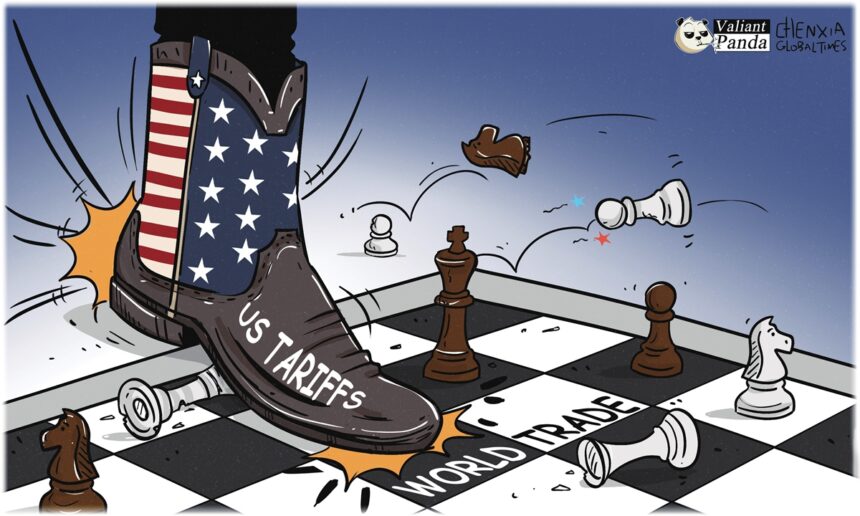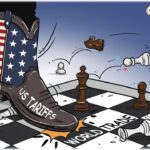By Li Meng-
The US government has been aggressively using tariff measures under the guise of “trade imbalance” and “protecting domestic industries,” imposing so-called “reciprocal tariffs” on major global trading partners. The US government announced a 90-day pause on its “reciprocal” tariffs for most countries, except for those imposed on China, on April 9. The White House claimed on Tuesday US time that China faces tariffs of up to 245 percent on its exports to the US.
Media outlets such as The Wall Street Journal noted that these developments indicate central focus of the US’ trade war, at least for now, is China. However, can other countries, which appear to be “taking a breather,” truly remain unaffected?
US aims to overturn global trade system
The US administration’s tariff strategy targets countries with significant trade deficits with the US, with China being the primary focus. However, the true purpose of the US government’s new tariff policy is not merely to address the trade deficit issue; it has a larger goal – to reshape the global trade order, according to experts.
The US aims to disrupt the existing global trade system centered around China, often referred to as the world’s factory, according to a report by the BBC on April 11.
Before this round of the tariff war, the US had already imposed a 25 percent tariff on imported steel, aluminum and automobiles, and had implemented export restrictions on products such as semiconductors, according to various media reports.
A recent CNBC survey indicates that while Chinese manufacturing has suffered losses due to tariff policies, US domestic manufacturing may not be the primary beneficiary. Most companies that responded to the survey told CNBC that bringing back supply chains could as much as double their costs and that instead a search for low-tariff regimes around the world will commence.
Arthur Kroeber, founding partner of consulting firm Gavekal Dragonomics, recently wrote in the Financial Times that the usual claims of the US for its tariffs do not hold up. The US’ stated aims often contradict each other, are contradicted by other policies or are obviously unachievable. In fact, the purpose of the US is to remove the constraints imposed by the global economic order on the unilateral exercise of US power.
The US government asserts that it wants to ” Make America Great Again” through tariffs. Its overarching objective is to establish a “US-centric trade system” and to coerce the world into accepting a US-led economic order through tariffs. As the world’s second-largest economy, China is seen as its biggest challenge, Li Haidong, a professor at China Foreign Affairs University, told the Global Times.
US tariffs to trigger chain reaction
The Wall Street Journal said in a report headlined “The US and China Are Going to Economic War – and Everyone Will Suffer” that the US’ tariff policy is having severe repercussions, highlighting that the tariff policies are causing significant disruptions, leading to volatility in stock, bond, and currency markets.
The US is wielding its tariff stick globally, directly impacting economies and livelihoods in many countries. The tariff policy may also lead to the disintegration of global supply chains, thereby affecting the industrial development of various nations, Bai Ming, an expert with a research institute under China’s Commerce Ministry, told the Global Times.
A Kyodo News poll on April 14 found 84.2 percent of respondents in Japan believe that the US’ tariff policies will affect their daily lives, while 73.9 percent of respondents believe that US tariffs are unjust. The concern extends beyond the business community, with growing public anxiety over the tariffs’ direct impact.
US tariffs doomed to fail
The US government plans to use ongoing tariff negotiations to pressure US trading partners to limit their dealings with China, The Wall Street Journal reported on April 16, citing sources familiar with the matter.
According to the report, US officials intend to ask more than 70 nations to block Chinese goods from transiting through their countries, prevent Chinese firms from relocating to avoid tariffs, and reject low-cost Chinese industrial products from entering their markets.
The US government adopted a targeted strategy: imposing high tariffs on China while exempting other countries. This selective pressure aims to undermine joint global resistance against it, Huo Jianguo, former president of a research institute under China’s Ministry of Commerce, told the Global Times.
While some nations may yield to pressure, most still prefer trade cooperation with China due to the global competitiveness and demand for its high-tech products. If major economies are forced to decouple with China, its could trigger a global recession, which would harm more countries, Huo warned.
Although the US has temporarily suspended tariffs on most countries, it does not mean that these measures are gone. Imposing tariffs on other countries is just a matter of time. The facts show that in the US’ tariffs, no country can “remain unscathed,” Li said.
The US imposed “reciprocal tariffs” on China, expecting China to make concessions, but failed to anticipate China’s immediate counter-tariffs and additional measures, He Weiwen, a senior fellow from the Center for China and Globalization, told the Global Times.
This shows China is not in a weak position and won’t bow to aggressive tariff pressure. With strong global opposition, coordinated countermeasures from many trading partners – especially China – and a worsening US economy, the so-called “reciprocal tariffs” are doomed to fail, He said.













